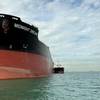Tanker Lay-Up Report from McQuilling Services
The following is a Tanker Lay-Up report from McQuilling Services, LLC:
One year ago we witnessed one of the highest tanker market earnings in the history of tanker shipping. Today the TD 1 trade returns about $500 / day in TCE earnings while there are about 50 large tankers employed as floating storage around the world. As these vessels re-join the fleet, on top of 38 VLCC and 33 Suezmax newbuildings expected to deliver before the end of the year, the markets may further deteriorate. In order to prevent possible future losses, and sometimes in hope to impact the markets, tanker owners engage in various fleet rationalization strategies. One of them is a possible vessel lay-up.
There are two types of vessel lay-up: The hot lay-up is intended for a relatively short period of time while a cold lay-up is intended for an extended period of time. Both types have an economic and technical aspect that ought to be discussed.
The hot lay-up takes a vessel out of the fleet for weeks or months at the time, with a readily accessible full complement of the crew for a rapid re-commissioning and re-entry into service. From an economic standpoint, the running costs of a vessel may result in about 40% savings during the extended periods of hot lay-up. Various savings may be found in daily insurance rates, registry costs, maintenance, crew costs, among others.
US $ / day Savings
VLCC 0 – 4,400
Aframax 0 – 3,200
MR 0 – 2,800
From a technical point of view there is a small difference between hull and machinery maintenance when trading versus while in hot lay-up. In hot lay-up, machinery will still need to be run to a certain extent. Some owners will even carry maintenance works in order to reduce the next dry docking time as much as possible, and perhaps compensate for some of the lost earnings while in lay-up. In order to further minimize costs, Classification Societies recommend to carefully choose the lay-up locations as warm waters produce more fouling, while strong winds and currents may require constant re-positioning.
On the other hand, a cold lay-up refers to months or even years of mothballing a vessel. In that case the running costs may be brought to a minimum. The crew compliment would be downsized (especially if a vessel is tied alongside), insurance and registry costs are also very minimal and there may be no repair and maintenance works taking place. Therefore, daily running costs may be reduced up to 75% of vessels’ normal operation.
However, the technical aspect of cold lay-up may be rather costly if not exercised properly. The ship machinery is built for constant operation and shutting it down for an extended period of time may cause all sorts of technical problems. Therefore, reactivation costs of cold lay-up are substantially reduced only if proper procedures are followed when lying-up vessels.
Furthermore, there are other than technical issues that tanker owners may be facing in the present marketplace if they decide to lay-up vessels. For instance, one of the concerns is where to position a vessel as many anchorages are already filled with other vessel types, while others no longer permit tanker vessel lay-up due to environmental factors. Furthermore, it is common for the crew to doubt the security of their jobs while the vessel is in lay-up, and therefore seek employment elsewhere.
Therefore, tanker lay-up is not a simple decision to be made. Realizing that, many ship agents, Classification Societies and maritime associations have been marketing their tanker lay-up services while technical and commercial guidance books are being published. The million dollar question is whether we will truly see modern tankers exiting the fleet for extended periods of lay-up because of the presently weak tanker markets?
In our opinion, tanker lay-up has historically been a product of long periods of low markets and persistently weak market outlook. While the market outlook remains relatively weak at the moment, this is only the second consecutive month of weak VLCC and Suezmax spot returns. Therefore, the hot lay-up option may start to emerge while consideration of cold lay-up is still likely over the horizon.












